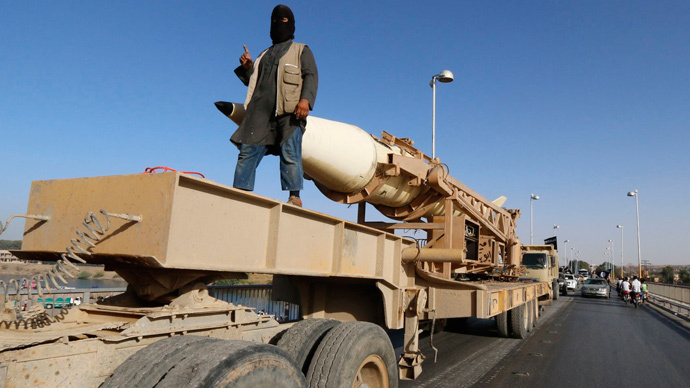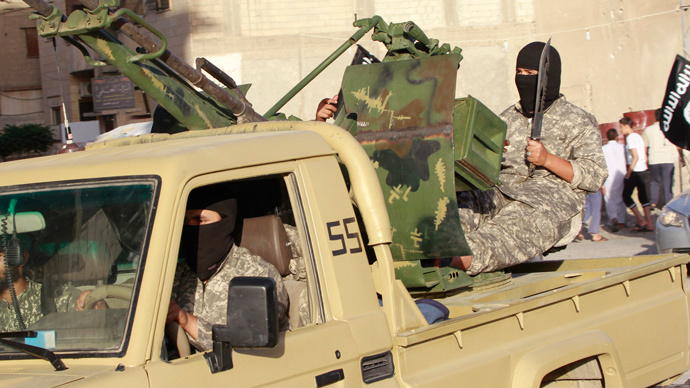The so-called Islamic State is the kind of group the US wanted for years - but couldn’t get - to put pressure on the Syrian government. At the same time, it didn’t stop the IS advance in Iraq and in Syria, political analyst Jeremy Salt told RT.
Iraq has admitted losing more than 2,000 Humvees and other weapons when Mosul was taken over by the Islamic State group (IS, formerly ISIS/ISIL) last year. The extremists posted images online, claiming they had seized US-supplied hardware. And that's not the only case of US weapons ending up in extremists’ hands. Last year, in Syria the US air-dropped weapons meant for Kurdish forces fighting the terrorists, but they fell in the wrong place and were found by IS fighters.
READ MORE: ‘2,300 Humvees in Mosul alone’: Iraq reveals number of US arms falling into ISIS hands
RT:Do you think Islamic State's advance would have been so successful without access to US military hardware?
Jeremy Salt: Let me just briefly revise the history of American so-called blunders over the last couple of years with regard to weapons ending up in the hands of Islamic State. The first one was the accidental airdropping of weaponry into IS-controlled territory - not once, but several times. Last year, in early June we had IS take over Mosul. Now here we have a state which has the most advanced, most sophisticated global surveillance system of any country in the world. It can actually watch you scratching your nose, it can hear you cough. Yet it didn’t see and didn’t hear those pickup trucks storming across the Syrian Desert in the direction of Mosul. Of course, when they got there it was a mess with American weaponry that they seized including 2,300 Humvees and massive weaponry and ammunition. Then just more recently that same scenario played out with Ramadi… They proudly went with a procession on the streets of Ramadi, a line of pickup trucks with men and machine guns that could have been obliterated from the air, exactly the same as Mosul.

So we have Mosul, we have Ramadi, we have a second seizure of immense Iraqi weaponry. Now we have a third kind of scenario when IS storms across the desert in the direction of Palmyra. Are we seriously to believe the US couldn’t see them coming, didn’t see those pickup trucks racing across the Syrian Desert when they create massive plumes of dust for one thing? They got to Palmyra and they took over the city. What explains all of this, this extraordinary history of blunders?
So we turned to recent documents released by the Defense Intelligence Agency in reply to the Freedom of Information [Act] request. This shows that in 2012, the US government knew and anticipated the possibility of a “Salafist Principality” being established in Eastern Syria and it said this wasn’t inconsistent with American policy and in fact the rise of these Salafist groups inside Syria was supported by all the governments that supported the Syrian opposition. And they knew that the opposition was not moderate. We had Joe Biden say exactly that… So what we are getting here is the real picture behind the picture that is represented by media.
RT:Do you think these blunders are going to help IS?
READ MORE: ISIS declares war on Shias on Arabian Peninsula – monitoring group
JS: I don’t think they are blunders. That’s the whole point. This is a strategy here. And I think this long-term strategy – and Israel is partner to this – is to break up the central lands of the Middle East into mini ethno-religious mini-states. It suits Israel’s purpose and it would suit America’s purposes. If you look at Iraq for example, the invasion in 2003, destroyed Iraq as a huge Arab state.
RT:The director of the CIA said on Sunday that the fight with Islamic State is set to last for a very long time. Do you see the US getting more involved in it over time or it’s just words?
JS: It’s just words. The US, as far as for Iraq is concerned in particular and even Syria, has not done a great deal to stop the advance of IS. If it seriously wanted to attack IS they could have attacked them when they moved to Mosul, Ramadi or Palmyra. They didn’t do a thing. So this is not all blunders and accidents, it’s indicative of a strategy at work. And the strategy I think is that in Iraq, in particular, the US is using IS like an attack dog… It’s giving IS a free hand in Western Iraq, in Mosul, in North-Eastern Syria. As I said that document predicted the rise of a “Salafist Principality” in North-Eastern Syria three years ago as a means of putting pressure on the Syrian government. In other words, IS is actually a kind of group the Americans wanted for years but couldn’t get.
The statements, views and opinions expressed in this column are solely those of the author and do not necessarily represent those of RT.
The statements, views and opinions expressed in this column are solely those of the author and do not necessarily represent those of RT.

